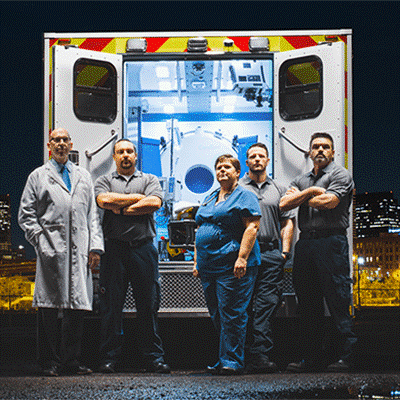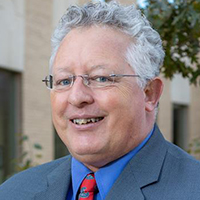In partnership with the UCHealth Mobile Stroke Treatment Unit, University of Colorado School of Medicine researchers are measuring blood samples of patients within minutes of stroke onset and discovering data that could change the way many stroke patients are treated.
Time of onset remains unknown in nearly a quarter of the 800,000 strokes in the United States each year, leaving patients unable to receive clot-busting medicines that have a short treatment window and can dramatically improve outcomes.
“There's nothing worse for a patient to know that there's a treatment available, but they don't qualify for it because we don't know for sure when the symptoms of stroke started,” said William J. Jones, MD, associate professor of neurology, neuro-hospitalist and vascular neurologist at UCHealth and medical director of the Mobile Stroke Treatment Unit.
With the new project, researchers are discovering how quickly neuroinflammation in stroke starts and speculating that this inflammation response holds clues to a stroke's timing and potential treatments.
‘Time is brain’
When it comes to stroke, experts say, “time is brain.” Typically, the quicker the response, the better the outcome for the patient.
|
|
Jones’ specially-trained Mobile Stroke Treatment Unit crew can run a CT scan, consult with a stroke neurologist via telehealth and administer thrombolytic treatment when indicated, all in the uniquely equipped ambulance.
The team has already demonstrated better outcomes for stroke due to its quick response, with 11 times more patients receiving life-saving treatment within 60 minutes when compared to standard treatment.
Now, in partnership with principal investigator Robert G. Kowalski, MD, MS, a physician and research faculty member in the CU departments of Neurosurgery and Neurology, and Michael Graner, PhD, the team hopes to better understand those crucial early minutes of a stroke.
Never before gathered data points
A little more than two years ago, researchers recognized a unique opportunity to collaborate with the Mobile Stroke Treatment Unit. Blood samples were already being taken to support clinical care. They became curious about what blood samples taken during an active stroke might reveal about the chemical response.
The first step was to receive IRB (institutional review board) approval to collect patient data without consent, which was needed because the patients are actively experiencing a stroke. Once this waiver was received, it allowed the team to obtain patient consent later during treatment. Now blood samples are taken from the patient at the exact time the patient’s brain is being scanned.
“This was almost unheard of prior to this study,” Kowalski said. “By looking at the biomarkers present in these samples, our hope was to get an idea of why some patients do better over the course of care.”
One finding leads to two potentials
The team’s most recent study examined 41 blood samples taken within 133 minutes of stroke onset. They found the biomarker levels for inflammatory molecules were higher than normal as early as 36 minutes after the stroke.
“What that told us was that the inflammatory cascade kicked off almost immediately,” said Kowalski.
This observation suggests injury from neuroinflammation occurs faster than previously thought. He says this is important for two reasons.
First, it has treatment implications.
“The finding indicates that there may be a rationale for treating these elevated inflammatory levels very early in the stroke.”
Second, one molecule, called interleukin-6 (IL-6), may help determine the time of the stroke's onset.
New study measures IL-6 real time
IL-6 is a well-studied molecule of inflammation and neuro-inflammation. The team discovered that the levels of IL-6 increase in a linear fashion after stroke.
“We have found that the farther away you were from the onset of stroke, the higher the IL-6 level, and all of these levels were higher than what occurs in a healthy adult,” Kowalski said.
These initial findings led to a collaboration with a bio-tech manufacturer with a device that uses a single drop of blood to measure IL-6, with results available within 20 minutes. Knowing these levels could lead to a better understanding of the stroke’s timing.
Why time matters
One of the most important factors in the successful treatment of stroke is administering treatment as soon as possible. A class of drugs called thrombolytics help to “bust” the blood clot during an active stroke to return the flow of blood to the brain.
But, with a quarter of stroke patients, the time of onset is unknown.
“It’s a real quandary,” Kowalski said. “There’s a massive benefit when the time of onset is known and thrombolytics can be administered within a 4.5-hour window. After that point, efficacy goes down, and the risk of bleeding goes way up.”
Jones said not knowing the stroke’s timing is one of the biggest difficulties faced by stroke neurologists and patients.
Creating a “profile” for stroke
Kowalski believes their team may have the largest biobank in the world of blood obtained during the early phase of stroke. It’s giving Graner, research director of the Neurosurgery Neural Tissue Bank, an opportunity to investigate the blood-based biomarkers of these very early data points.
“We’ve noticed a number of different components that are measurable,” he said. “They aren’t changing as fast as the IL-6, but it does demonstrate that other things happening at the cellular level may be responsible.”
He theorizes that IL-6 is not the only measurement of neuro-inflammation caused by stroke and aims to help clinicians improve treatment by knowing how stroke changes the overall cellular makeup.
More options for diagnostics and treatment
The team is hopeful that the IL-6 data can lead to treatments that can protect the brain once the inflammatory cascade starts.
“Through this research, we’re asking the question: Can we give you something that's going to protect the neurons from dying and allow them to recover down the road?” Jones said.
Note: Other team members include: Aurélie Ledreux, MS, PhD; John E. Violette, RT; and David Ornelas BSN, RN.
Guest contributor: Carie Behounek is a writer specializing in health and science.







